TL;DR
- Stem cells are your body’s core cells from which every specialist cell is born. These cells also repair and replace damaged ones that cannot do that independently.
- A hair transplant that contains stem cells is the process where healthy stem cells are extracted from the donor area to the balding area of the scalp.
- UVA researchers (2024) found new stem cells in upper/mid hair follicles that fuel growth. Kill them → hair stops; reactivate them → baldness reverses. Potential game-changer for non-surgical treatments. [1]
- UnitedCare uses Regenera Activa to stop hair loss and promote hair growth through stem cell hair transplants. It is very affordable compared to other clinics worldwide.
Did you know that the average person is born with 100,000 hair follicles, and not a single hair follicle is produced on your scalp ever again?
Although the hair grows and falls and then grows again from these follicles, which can be thought of as the factory of hair, when the follicles themselves fall out, they’re never replaced.
And that’s what makes hair loss an issue that 50% of men have to go through by the age of 50.
But, the innovative discoveries made around stem cells can actually keep your hair follicles healthy and strong for years and carry hair restoration procedures to a whole new level.
In this blog, I want to talk about what these new discoveries are and how exactly they’ll help us:
Table of Contents
Also, I’ll tackle a few misconceptions about the topic.
But let’s start with the basics:
What are Stem Cells?
Stem cells can be referred to as your body’s raw materials.
They are the very basic form of animal cells which all the other specialist cells are derived from. In addition to enabling us to understand the wonders of our systems and cells, stem cells are also used to repair and replace cells we can’t replace on our own.
Similarly, they can, in the future, be used to create and replace any of our organs or tissues; that’s where the interest in them derives from.
That potential makes them a significant and exciting discovery in the field of biology and medicine:
Stem Cell Procedure Background
It was 1961 when James Till, a biophysicist, and Ernest McCulloch, a cellular biologist, first discovered stem cells at Ontario Cancer Institute, Canada.
However, their research didn’t echo at the time because it was initially more theoretical than practical. Later, as the technology caught up to understanding and utilizing the potential of stem cells, a sudden influx of attention flowed through the stem cell theory.
When extracted from your bone marrow or bloodstream and injected back into damaged tissues, they show significant improvements in speed and extent of healing.
Today, with a billion-dollar industry revolving around this magnificent discovery, thousands of scientists are trying to take a step toward the future using these stem cells, including experts in dermo-cosmetics and hair restoration.
We can see how big the potential is once we understand how stem cells work:
How Exactly Does Stem Cells Help?
Stem cells extracted from your blood through a centrifuge machine like Rigenera Activa are then injected back into the area that the healing promotion is intended for. After this injection, stem cells start to multiply and reinforce the damaged tissue.
Also, since stem cells are your own body’s agents, they have minimal side effects and, compared to most regenerative treatments, yield the best results:
What Are the Side Effects of Stem Cells?
Stem cells are relatively safer than most hair restoration options. However, they still include some amount of mild side effects.
The side effects of stem cells used in hair restorations include redness, swelling, bleeding, numbness, irritation and discomfort in the scalp.
The important thing to notice is that these side effects are common and quite mild concerns that all hair transplants contain. Also, these side effects fade away within a week post-surgery.
⚠️ If any side effect continues for too long, remember to contact your doctor immediately.
That being said, its benefits as a hair restoration solution outweigh these side effects:
What Is a Stem Cell Hair Transplant?
A stem cell hair transplant is a medical hair restoration process where we extract scalp tissues from the donor area using a medical punch device. Then, we extract stem cells from the tissue using centrifugation before injecting them into bald areas of the scalp.
Due to this medical process, its tools and research are relatively new:
Stem Cell Hair Restoration Background
In a 2017 study, researchers from the University of Rome School of Medicine developed a new method to separate human stem cells from the adipose tissue harvested using a punch biopsy tool.
They conducted an experiment on 11 patients with male pattern baldness in the late stages, aged between 38 and 61.
They injected the patients with the stem cells they harvested from each patient’s donor area. This study was a defining work for stem cell hair therapies since they saw a 29% increase in hair density in a matter of just 28 weeks.
Therefore, the success of stem cell hair transplant is a 29% ±5% increase in hair density.
This study kicked a significant amount of excitement in the field of hair restoration since it can mean that patients can battle hair loss without any serious surgical procedure, with their body’s own resources.
But how exactly does the process work?
2024 – 2025 Stem Cell Hair Transplant Updates
In 2024, Researchers at the University of Virginia discovered a new stem cell population in the upper/mid follicle regions (not the bulge), which migrate downward to nourish hair follicles. Depleting these cells halted hair growth, while reactivation could reverse baldness.
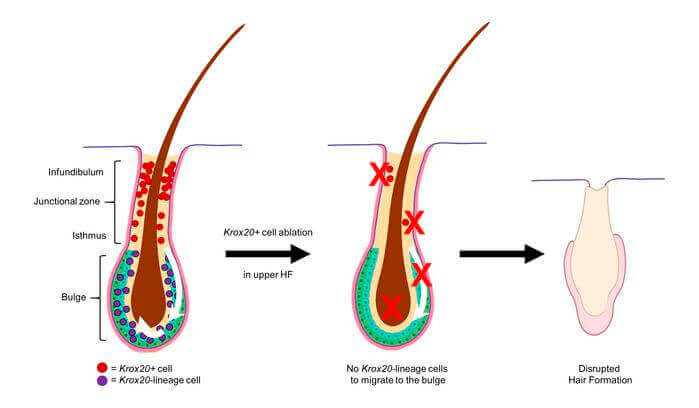
There is an very critical comment of one of the researches that is:
Importantly, we found that in the human bald scalp, although the hair shafts are gone, this population of novel hair stem cells is still present in the upper hair follicle. This means that if we could reactivate these cells to migrate down and repopulate the bulge, they could potentially regrow hair on a bald scalp.
Lu Q. Le, MD, PhD, Virginia Med. News
In another study done by UCLA scientists [2], it is found that PP405, a topical molecule, blocks a protein that keeps hair stem cells asleep. After a decade of lab work, 2023 human trials showed that applying it nightly for a week woke up follicles—growing real, thick hair, not just peach fuzz. UCLA called the results “statistically significant” but is still cautious [2].
Stem Cell Hair Transplant Process
In this section, I’ll dive deeper and look into the process of a stem cell transplant for MPB and androgenetic alopecia step by step:
Harvesting Tissue in Stem Cell Transplant
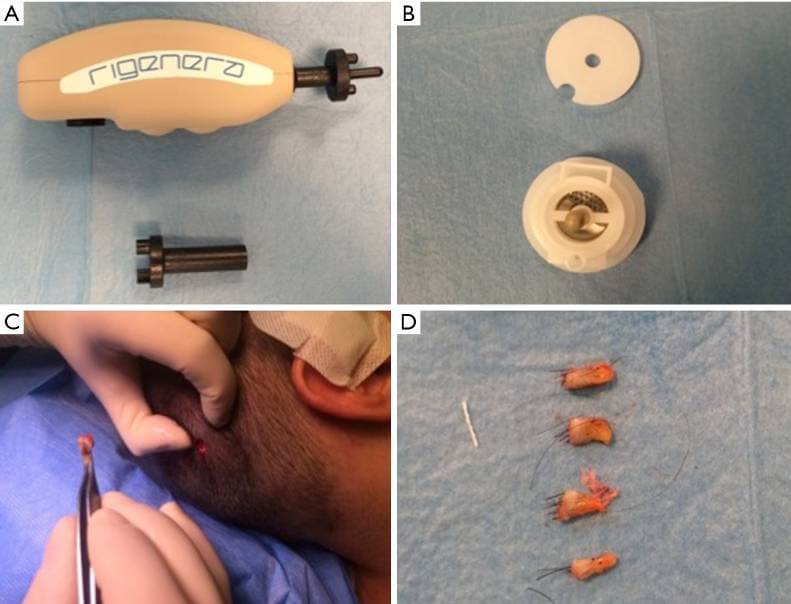
Initially, the surgeon will need deep tissue from the donor area to extract stem cells. So, using a biopsy punch tool called “Rigenera Securdrill Device”, tissue is extracted from the scalp.
Then, these scalp tissues are cut into strips of 2 mm by 2 mm to more easily separate stem cells in the next step.
Extracting Stem Cells from Tissue
The cut strips of tissue are then centrifugated at 80 RPM per minute using a centrifuge tool like Rigenera Activa, which is a device that can separate fluids and solids of different densities from each other.
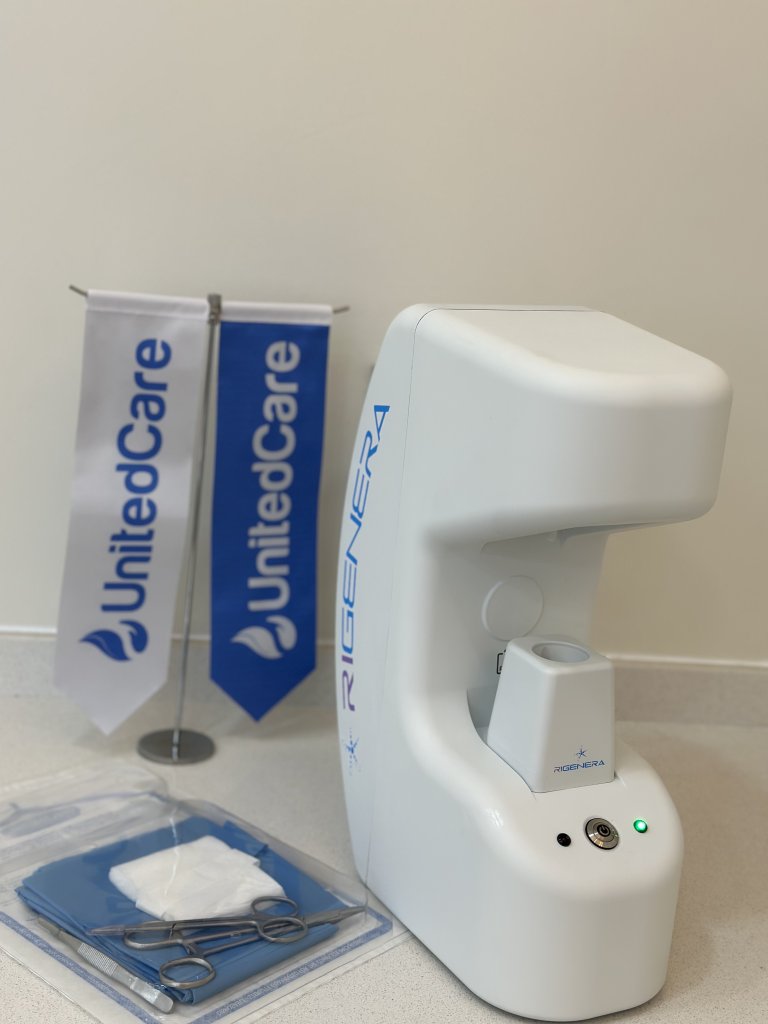
60 seconds later, the suspension that is separated from the tissue that contains stem cells is filled into a mechanical injection device.
Injecting Stem Cells Into the Scalp
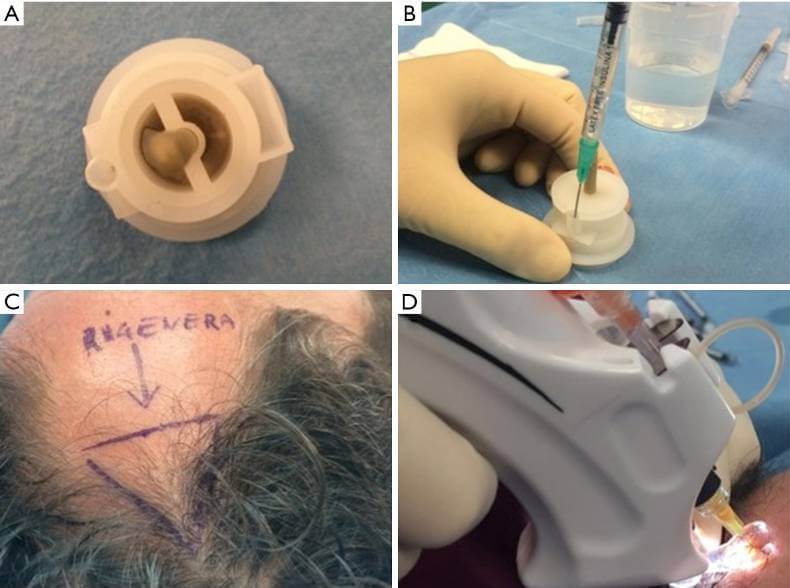
In the final step, these mechanical injector is used to inject the solution into the patient’s skin, targeting the bald areas of the scalp.
Stem Cell Hair Transplant Healing Period
The punch used in stem cell hair transplantation is much bigger than in regular hair transplants. Therefore, it causes a relatively more extensive but small number of wounds that take a while to heal.
The punch size I use in my FUE operations is 0.8 mm
Stem cell hair transplant punch size is: 3 or 4 mm
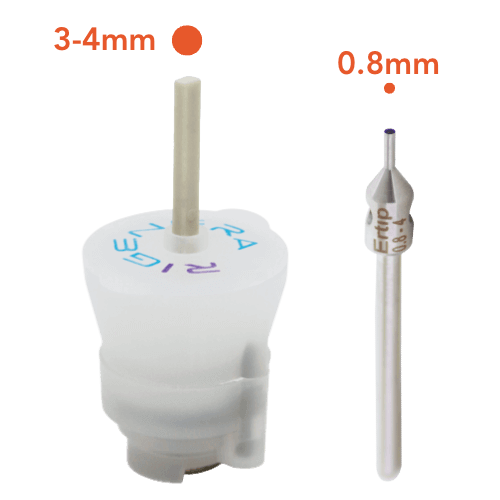
In FUE operation, 3000-4000 holes are opened with FUE punches. However, in stem cell hair transplant, 3 to 5 holes are enough.
👉 Even if the number of holes is low in stem cell operation, resting a couple of weeks and good wound care is a must due to relatively big punch wounds.
There is NO hair shedding, shock loss, or growth phases after a stem cell hair transplant as a regular hair transplant. Other than wounds on the back of the head, there is nothing to be healed.
Therefore, a patient can start daily activities after a week when the wounds crust over, which protects wounds from sweat and dust.
💡 However, a patient should use 50+ sunscreen until the wounds are healed in 4 to 6 weeks after the stem cell hair transplant in order to avoid sun spots on punch wounds.
To give my own medical opinion, I advise every patient to maintain proper hair care at least 6 weeks after the surgery, even if the pain fades away. Regularly use a prominent sunscreen during this time, and you can return to your ordinary hair care routine only with your doctor’s approval.
Remember that waiting at least a week after all the big wounds are completely healed and crusts are finished before starting daily activities is beneficial.
By following a proper healing guide, you can support your stem cell hair transplant’s success:
Do Stem Cell Hair Transplants Even Work?
The reason numerous experts refer to stem cell hair transplants as the next step in hair restoration is that they are extremely promising, especially considering the study I’ve just mentioned.
Here is one of the patients who underwent the experimental stem cell therapy and his results at the beginning of the study, 3 weeks later, 9 weeks, and 23 weeks following the injection, respectively.
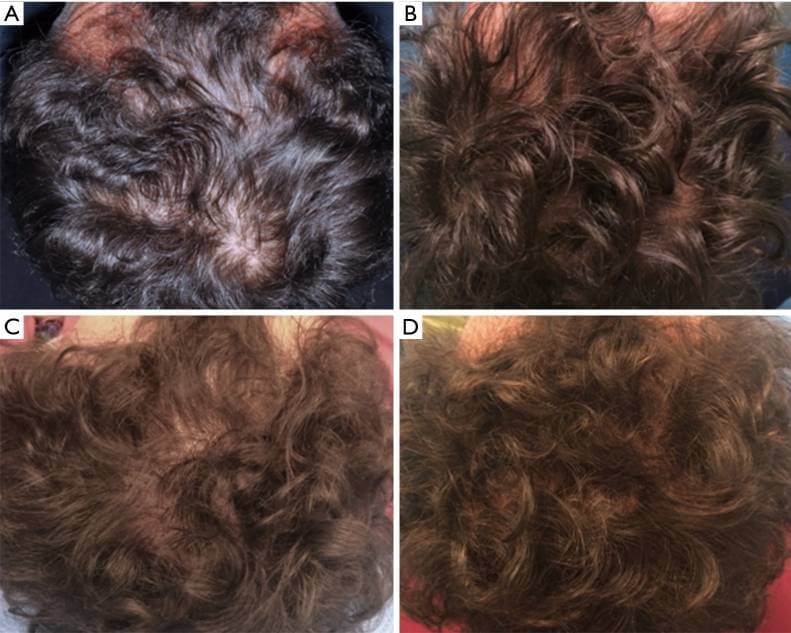
As we’ve mentioned in a previous section of this blog, the researchers observed a 29% average increase in hair density 23 weeks after the injection. This increase is much more than every other non-surgical hair restoration method in much less time.
Furthermore, as stem cells’ main benefit is increasing hair density, they can be used as a supporting method before a hair transplant procedure such as FUE:
Stem cells can be applied before or after the surgery to increase the success of a FUE hair transplant. It has been proven that surgical wounds heal faster, the rate of hair regrowth increases, and the duration of shock hair loss gets shortened.
But, to prove its effectiveness and develop more efficient variations, stem cells and hair regrowth should be explored further with more studies and research.
How Long Does an Implanted Stem Cell Last?
Although stem cells have proven that they can act as a solid way to fight hair loss, they may NOT be a one-off operation.
Just like various other non-surgical treatments that include injections or laser therapies, stem cell injections may need to be done on a regular basis to keep your hair healthy and strong.
Or they may not. Once the lack of published research on this subject is clear, we can have a better understanding of the exact steps of the process. 🔍
How Much Does a Stem Cell Hair Transplant Cost Worldwide?
The cost of a stem cell hair transplant at UnitedCare Clinic Turkey is 1000€ as of 2025.
The average worldwide costs of stem cell hair transplant in 2025 are as follows:
Turkey: 1000€ – 3000€
USA: 5000$- 15000$
England: 3000£ – 8000£
India: 1000$ – 2500$
Will Stem Cells Cure Baldness?
Most experts, including myself, agree that the future of hair regrowth and treatment of hair loss is in stem cells.
Unless there is a brand new method that will cure baldness once and for all, stem cell therapies and stem cell hair transplants seem to be the next step in hair restoration.
BUT, the important part here that I would like to emphasize is that stem cells, like any other treatment in the literature, does NOT grow new hair follicles. Their effectiveness lies in increasing the existing hair’s density. That way, stem cells can stimulate hair growth and regeneration.
Today, stem cell injections are scientifically proven to help with slowing down hair loss and promoting hair growth, if you’re in the early stages of your hair loss.
And you can get a top-of-the-line and affordable stem cell treatment at UnitedCare.
However, if your hair loss has progressed, you might need the help of additional treatments to restore your natural look:
Definitive Solutions to Balding: DHI and Sapphire FUE
Although stem cells are much more promising, they won’t help you get back to your natural self and appearance by this time next year.
But, FUE and DHI hair transplants enrichened with bio-enhancements will.
At the moment, the most efficient and the most advanced hair restoration methods are two variations of the traditional FUE:
1️⃣ Direct Hair Implantation: DHI, invented by DHI Medical Group in 1999, is a modified variation of FUE where an implanter pen replaces forceps and scalpels used in the implantation stage of hair transplant surgery. This way, the action is reduced to a single motion, which allows for better control over the angle and depth of implantation. The recovery time is faster, the scarring is much less, and the end quality is much better.
2️⃣ Sapphire FUE: Sapphire FUE is also a modified version of FUE that replaces scalpels with a scalpel knife that has a sapphire tip, which makes it much sharper and allows for even smaller incisions. With Sapphire FUE, the recovery and angles of incisions are much better, and the results look even more natural.
🧪 Bio-Enhancements: In traditional FUE and FUT surgeries, the harvested grafts are kept out of the body in proper storage liquid, which can harm the grafts and damage them, lengthening the healing process. With bio-enhancements such as liposomal ATP, HypoThermosol, and ACell, along with PRP injections used throughout the surgery, experts have seen a drastic increase in the recovery periods.
So, even though the future of hair restoration is not here yet, you can still restore your natural hair today with the expert touch and the proper techniques:
Take the First Step With UnitedCare
At UnitedCare, we believe in progress and success.
We believe that medicine is progressing forward and will eventually find a much better and much more efficient way of treating hair loss. So, we adopt clinically proven and regulated strategies to ensure we do our best to help our patients succeed.
As a dermatologist duo with 20 years of combined experience, we’ve adopted a holistic approach to hair loss; stem cell treatments combined with DHI/Sapphire FUE and bio-enhancements and helpful medications to restore your natural hairline.
So you can stop worrying about your hair loss for good.

We’re just a click away 👇
Your current best bet for success is here at UnitedCare.
Ensure the success of your hair transplant with Stem Cells, FUE surgeries, and bio enhancements:
Frequently Asked Questions (FAQs)
How much does the stem cell hair transplant cost?
Although the method isn’t yet cleared or approved by the U.S. FDA, you can get a stem cell hair transplant in investigational clinics in other parts of the world, with costs ranging between $4000 and $10,000. The cost will change according to what you need, what the clinic charges on a basic level, and, of course, the country the clinic is located in.
Can stem cells cure baldness?
The potential of stem cells is unlimited, and the thought of stem cells being the complete and absolute cure for baldness makes sense. Currently, injections of stem cells deep into the tissue in bald areas of the patient’s scalp are being tested in various clinics with great promise of success.
Are stem cells the same as PRP?
Platelet-rich plasma (PRP) and stem cells are two different agents. Although PRP injections promote growth and healing, stem cells can actually regenerate and even replace damaged or destroyed tissue in the target area. Also, stem cells have returned much better results than PRP injections in healing and promoting growth.
How long does it take to recover after a stem cell hair transplant?
For the safest scenarios, you should wait 4 to 6 weeks after the stem cell hair transplant and use 50+ sunscreen until the wounds are healed in order not to have sun spots on punch wounds. However, they can start daily activities after a week when the wounds crust over.
What are the side effects of stem cells?
Stem cells are relatively safer than most hair restoration options. Yes, there is indeed a slight chance for some side effects. However, its side effects are pretty mild. These include redness, numbness, bleeding, swelling, and discomfort in the transplant areas. Remember that these side effects are directly connected to the natural side effects of hair transplants and should fade away within a week after surgery. So, if they do not, contact your doctor immediately.
What Is The Success Rate Of Stem Cell Hair Treatment?
Stem cells are relatively new compared to other hair restoration techniques. So, it is difficult to say for certain. However, a 2017 study made on 11 patients deduced that the success of stem cell hair transplant was a 29% ±5% increase in hair density.
Are Stem Cell Hair Transplants FDA-Approved?
Although the FDA approves stem cell-based treatment for blood transplantation, it has yet to be approved for hair transplants as of 2025.

[1] Ghotbi, E., Tchegnon, E., Chen, Z., Li, S., Shipman, T., Wang, Y., … Le, L. Q. (2024, October 3). Transcription factor KROX20 marks epithelial stem cell ancestors for hair follicle formation. JCI, 134(23), e180160. https://doi.org/10.1172/JCI180160
[2] Did UCLA Just Cure Baldness? John Harlow UCLA News.
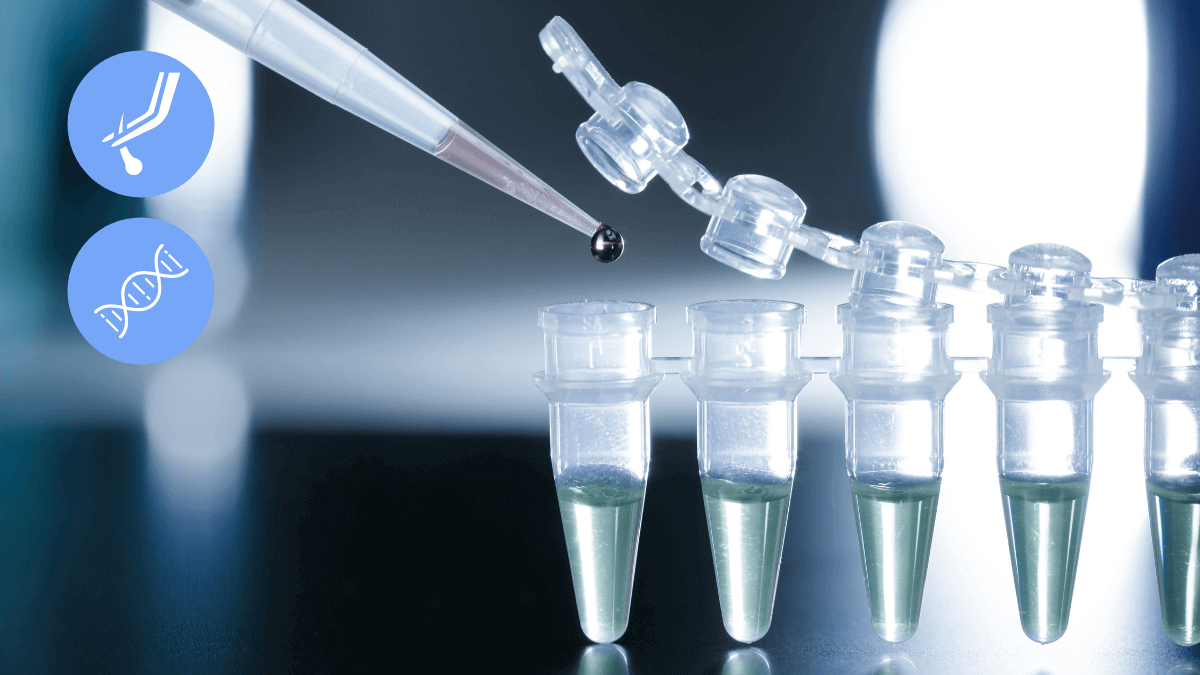
Dear Dr.
It is a well written article with clear explanations on current state of that new technique.
Please tell me when that will be approved and with effective result and operational in Turkey.
I have go many old bad French surgeries FUT (so I distrusted them) followed by much better FUE in Turkey (Istanbul). But now my donor zone is bad and I am 64 yo…So Is there any future hope?
Also what do you think of micropigmentation?
I look, forward to hearing from you.
France.
Hello Franck,
Thank you for your kind words.
Unfortunately, there is no treatment in the literature showing completely new hair follicle growth out of stem cells. Mesenchymal stem cells can evolve into other cells, but they are not shown to produce new hairs out of nowhere.
Regenera Stem Cell, or other treatments like G-cell, can’t multiply or create hairs out of stem cells. However, they are proven to increase hair density. (29% density increase in treatment area, 1% in the placebo area in a study.)
So, the marketed treatments are to stimulate hair growth and regeneration.
To see what’s are the newest hair transplant methods and what’s possible, you can check out my article.
Best.
Thank you for your professionalism!
Franck
Hey I just wanted to know if stem cell injection therapy should be done before an FUE procedure and how many days before a hair transplant can you do stem cell injection?
Hello Hamza,
It can be applied even one day before a hair transplant.
When stem cell therapy is applied before/after hair transplantation, it has been proven that surgical wounds heal faster, the rate of hair regrowth increases, and the duration of shock hair loss is shortened.
Best.
Hi doctor.
What treatment would you recommended at current time, Stem cell or Fue for density and more natural look?
Regards
Hello Tarik,
I can’t express my opinion without seeing your condition.
Please contact my friends via this page and send your photos.
Best.
Hello Dr utkan. Hope you’re doing well.
Thank you very much for your very informative article. I have only one inquiry.
I would like to know what is the difference between regenira activa and G-cell therapy? I have searched deeply to know which one is better as i know each one has a different mechanism. As far I Know regenira works in grinding the tissue then inject it while G-cell work on only do cell suspension. The tissue suppose to have more life span in comparison to cells. So please let me know. And whose the best choice to go with.
Greetings. Ahmed
Hello Ahmed,
To be honest, there is no comparative scientific study conducted by independent institutions; studies are often biased.
Based on my own experience and the experiences of my fellows, I can say that there are no visible differences between the results of Regenera Activa and G-cell therapy.
Best.